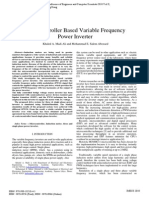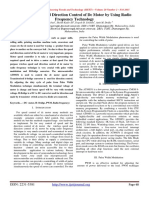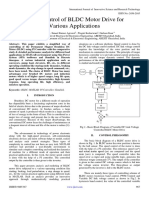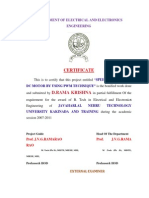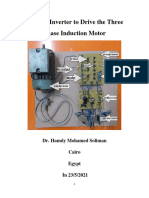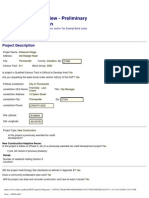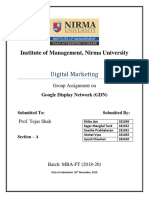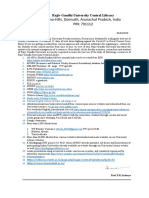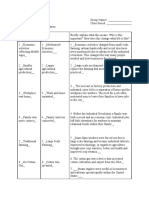Digital Speed Control of DC Motor For Industrial Automation Using Pulse Width Modulation Technique
Digital Speed Control of DC Motor For Industrial Automation Using Pulse Width Modulation Technique
Uploaded by
vendiCopyright:
Available Formats
Digital Speed Control of DC Motor For Industrial Automation Using Pulse Width Modulation Technique
Digital Speed Control of DC Motor For Industrial Automation Using Pulse Width Modulation Technique
Uploaded by
vendiOriginal Description:
Original Title
Copyright
Available Formats
Share this document
Did you find this document useful?
Is this content inappropriate?
Copyright:
Available Formats
Digital Speed Control of DC Motor For Industrial Automation Using Pulse Width Modulation Technique
Digital Speed Control of DC Motor For Industrial Automation Using Pulse Width Modulation Technique
Uploaded by
vendiCopyright:
Available Formats
See discussions, stats, and author profiles for this publication at: https://www.researchgate.
net/publication/315822742
Digital Speed Control of DC Motor for Industrial Automation using Pulse
Width Modulation Technique
Conference Paper · July 2017
CITATION READS
1 1,165
4 authors, including:
Anthony Uwakhonye Adoghe Segun I. Popoola
Covenant University Ota Ogun State, Nigeria Manchester Metropolitan University
36 PUBLICATIONS 113 CITATIONS 99 PUBLICATIONS 495 CITATIONS
SEE PROFILE SEE PROFILE
Prof. Aderemi A. Atayero
Covenant University Ota Ogun State, Nigeria
236 PUBLICATIONS 913 CITATIONS
SEE PROFILE
Some of the authors of this publication are also working on these related projects:
Wireless networks View project
Energy Management View project
All content following this page was uploaded by Prof. Aderemi A. Atayero on 07 July 2017.
The user has requested enhancement of the downloaded file.
Proceedings of the World Congress on Engineering 2017 Vol I
WCE 2017, July 5-7, 2017, London, U.K.
Digital Speed Control of DC Motor for
Industrial Automation using Pulse Width
Modulation Technique
Anthony U. Adoghe, Simisola O. Aliu, Segun I. Popoola, Aderemi A. Atayero, Members, IAENG
Over the years, various DC shunt motor speed control
Abstract— Precise speed control is an important techniques have been employed. In flux control approach,
requirement for efficient industrial automation. Direct current the motor speed increases as the rate of flux decreases. The
(DC) motors have been extensively used for this purpose. The rate of flux changes when the shunt current is varied using a
conventional method employs analog circuits to control the
shunt field rheostat. Since the shunt current is relatively
speed of the DC motor by varying the voltage of the armature
while the field voltage is kept constant. In this paper, a digital small, the shunt field rheostat has to carry only a small
speed control of DC motor using pulse width modulation current which results in low I2R loss, such rheostat is small
technique was implemented by replacing analog circuit with an in size. This method is therefore very efficient [3].
Atmel AT89S52 microcontroller circuit. An experimentation of The rheostat control method is suitable when speeds below
the design showed that the DC motor can run forward the no-load speed are required. With a constant supply
motoring, forward regeneration, reverse motoring and reverse
voltage, the voltage across the armature is varied by
regeneration. This digital approach proved to have increased
precision and greater control efficiency. Thus, a centralized inserting a variable rheostat in series with the armature
control of several motors can also be achieved. circuit. For a constant load torque, the speed is
approximately proportional to the potential difference across
Index Terms—DC motor speed control, microcontroller, the armature [3]. However, this technique is inefficient,
pulse width modulation, quadrant choppers expensive, and not suitable for rapidly changing loads. For
better improvement, a diverter can be connected across the
armature in addition to the armature control resistance.
I. INTRODUCTION The voltage control method may be multiple voltage control
A UTOMATION of industrial processes offers the benefits
of better quality, increased production and control, and
decreased costs. Several industrial automation processes
or Ward-Leonard system. In multiple voltage control, the
shunt field is permanently connected to a fixed exciting
voltage but the armature is supplied with different voltages.
utilize electric motors for control functionalities. This This is achieved by connecting the armature across one of
requires the electric motor to operate at different speeds and the several different voltages by means of suitable gear. The
in different modes. High starting torque and controllability intermediate speeds can be obtained by adjusting the shunt
of Direct Current (DC) motors has led to their wide range field regulator. However, this method is not frequently used.
usage in industrial processes that require accurate and The Ward-Leonard method is used where an unusually wide
precise speed control. and very sensitive speed control is required. However, its
DC shunt motors are considered appropriate for most overall efficiency is low at light loads [3].
industrial control due to their advantageous features. They Prior to the advent of power electronics and
operate at approximately constant speeds. For the same microcontrollers, it has been very difficult to realize variable
current input, the starting torques is not as high as in series speed of DC motors in any application. Today, solid-state
motors. To maintain an approximately constant speed from electronic devices have become a better choice for DC
no-load to full-load, the shunt regulator enables the required motor speed control [11]. These devices control the motor
speed control easily and economically. DC shunt motors speed by adjusting either the voltage applied to the motor
have wide range of applications which include driving armature, the field current, or both [6]. Unipolar pulse width
constant speed line shaft loads, lathes, centrifugal pumps, modulation is suitable for cases where the reversal of motor
machine tools, blowers and fans, and reciprocating pumps direction is not required. A bidirectional DC motor speed
[1]. They achieve higher accuracy, greater reliability, quick control can be achieved using the H-bridge integrated
response, and higher efficiency since there are no I 2R losses. circuits controlled by a microcontroller [7].
A full four-quadrant control is possible to meet precise high- In this paper, we design and implemented the digital speed
speed requirement [2]. control of DC motor using pulse width modulation
technique. The analog circuit was replaced with an Atmel
Manuscript received February 23, 2017; revised March 28, 2017. AT89S52 microcontroller circuit. Similar to the traditional
approach, the field voltage was kept constant while the
A. U. Adoghe, S. O. Aliu, S. I. Popoola, and AAA. Atayero, armature voltage was varied. The switching action was done
Department of Electrical and Information Engineering,
Covenant University, Ota, Nigeria. by four-quadrant choppers which utilized Metal–Oxide
{anthony.adoghe, atayero} @covenantuniversity.edu.ng, Semiconductor Field-Effect Transistors (MOSFETs). The
segunpopoola15@gmail.com
ISBN: 978-988-14047-4-9 WCE 2017
ISSN: 2078-0958 (Print); ISSN: 2078-0966 (Online)
Proceedings of the World Congress on Engineering 2017 Vol I
WCE 2017, July 5-7, 2017, London, U.K.
motor was connected to the Optoisolator-MOSFET Figure 2: Block Diagram of Power Supply Unit
circuitry. Optoisolators accepted the input signals from the
Three different power supplies were used to supply
microcontroller and provide instructions to the integrated
appropriate operating voltage to the microcontroller unit and
circuit that controls the MOSFETs. The Microcontroller is
two DC motors respectively. A series connection of two
connected and programmed to work with a Liquid Crystal center-tap step down transformers of 15 V output voltage
Display (LCD) unit and a keypad. each fives a total power rating of 30 V, 5 A. The 30 V
The remainder of this work is organized as follows: output of the transformer was fed into the bridge rectifier
Section II gives the materials and explains the methods circuit. The diodes employed in the rectifier circuit have a
employed; Section III presents the system implementation forward bias of 0.7V each. A 12 V zener diode and 7805
and testing procedures; Section IV discussed and voltage regulator IC control the DC output of the filter
summarized the results obtained. circuit. The output voltage of the regulator circuit is 5 V that
is required for the operation of the microcontroller unit [13].
II. MATERIALS AND METHODS
B. The Microcontroller Unit
Correct design specification is required for efficient
A microcontroller is made up of a powerful processing
system performance. The design parameters considered unit integrated with memory, and various input and output
include input voltage, output voltage, maximum current, interfaces, all on a single chip. The use of a microcontroller
frequency of operation, voltage control steps, and direction reduced the size of the Printed Circuit Board (PCB) and the
of rotation. The DC motor controller operates at 6 V/12 V cost of design.
with a maximum current capacity of 5 A. The system The programmable microcontroller used in this work is
operates at a frequency of 50 Hz. The input AC voltage is AT8952. The choice of this microcontroller is due its small
within the range of 150–270 V. A digital display is required size and cheap price. It has a 4 KB of in-system
to show the exact value of the input and the output voltages. programmable flash memory, 1000 write/erase cycles, 128 x
Also, the current speed and direction of rotation should be 8-bit internal Read Only Memory (RAM), two 16-bit
displayed. Switches control the desired voltages (6 V/12 V/ timer/counters, and six interrupt sources. It is also equipped
24 V), the speed range from 1 to 100 in steps of 1 and 5. The with full duplex UART serial channel, low-power idle and
direction can be either clockwise or anticlockwise. power-down modes, watchdog timer, and dual data pointer
The complete system consists of six (6) different units. [10]. In addition, AT8952 has a high speed of program
This include the power supply unit, the microcontroller unit, execution and high processing capability. The interface and
optoisolator unit, the LCD display unit, the MOSFET the memory was adequate for the task at hand since it has to
chopper unit, and the DC motor. This block diagram in learn only 35 single word instructions. The above-
Figure 1 shows the interconnections of the various units. mentioned requirements facilitate the choice of the AT8952
chip.
All the instructions for control functions are programmed
into the microcontroller. The 5 V DC output of the power
supply is connected to pin 40 of the microcontroller. The
microcontroller uses a pull down resistor connected to port
0, and a crystal oscillator of 11.0592 MHz in conjunction
with a couple of capacitors of 27 µF. The resistor and the
crystal oscillator were connected to pins 18 and 19 of the
microcontroller for stable oscillation as shown in Figure 3.
C. The LCD Display Unit
The unit is responsible for the digital display of output
information. The LCD was properly interfaced to the
microcontroller as sown in Figure 4. The data pins of the
Figure 1: Block Diagram of the System LCD were connected to port 2 of the microcontroller.
D. The Keypad Unit
A. The Power Supply Unit The keypad allows the user to input required instruction to
The power supply is made up of the transformer, the the microcontroller as predetermined. There are eight keys
rectifier circuit, the filter circuit, and the regulator circuit. on the keypad for different operations as shown in Figure 5.
The circuit arrangement is shown in Figure 2. Two The keypad switches were connected to port 1 of the
transformers are used to step down the AC voltage of 230 V microcontroller. The possible operations include the
to 15 V. The diodes converts the input AC current into DC. switching function, speed control function, the changing of
This is known as rectification. The rectified output is a the output voltage, and the changing of direction of rotation
rippled DC which requires filtering. The ripples are filtered of the DC motor.
using a capacitor arrangement. A positive voltage regulator
is used to control the output DC voltage.
ISBN: 978-988-14047-4-9 WCE 2017
ISSN: 2078-0958 (Print); ISSN: 2078-0966 (Online)
Proceedings of the World Congress on Engineering 2017 Vol I
WCE 2017, July 5-7, 2017, London, U.K.
15
A
GND
1
3
B. The Optoisolator Unit
VO
180R LCD
+5V
2
VCC
R/W
5
The optoisolator was used to transmit signals or data
K 16
across an electrical barrier using a beam of light, and it
RS
D7
D6
D4
D5
D3
D2
D1
D0
E
14 13 12 11 10 9 8 7 4 6
R25 1k
achieved an excellent isolation [12]. In this work, they were
28 27 26 25 24 23 22 21 10 11
C14
27pF used in the transfer of on-off control signals for switching
560R 560R
P2.7
P2.6
P2.5
P2.4
P2.3
P2.2
P2.1
P2.0
P3.0
P3.1
560R
560R
560R a
560R
39
38
P0.0
P0.1
XTAL1
18
purposes and for circuit isolation. The second pins of all the
b X2
c
37
P0.2 atmel8952 16MHz
optoisolators were interconnected while the first pins were
10µF
C5
9 19
reser XTAL2
connected to resistors. Interchanging the positions of the
P1.5
P1.4
P1.3
P1.2
P1.1
P1.0
P0.6
P0.5
P0.4
P0.3
P1.7
P1.6
VDD
VDD
VSS
10k C12 27pF
20 31 40 33 34 35 36 8 7 6 5 4 3 2 1
+5V pins and the optoisolators changes the direction of rotation
of the DC motor. The optoisolator supplied an input to the
anticlk
0n/off
volts
clk
-5
+5
+1
-1
560R
560R
microcontroller. The microcontroller processes the
g
information and display the appropriate output on the LCD
560R
560R
display unit.
f
560R
C. The MOSFET Chopper Unit
560R
e A chopper is a DC to DC converter with a variable DC
560R
560R
voltage [9]. The MOSFETs acted as switches as shown in
d Figure 6. They are employed to switch on and off the power
Power supply
supply to the load for a certain time interval. This was
12V Transformer
achieved by varying the firing angle. By so doing, the speed
AC
240V
1N4007
+5V
of the DC motor was controlled.
1,000µF
1,000µF
7805
D. Software
1N4007
Keil µVision3 software, Express PCB, and Express SCH
Figure 3: The Microcontroller Unit were used for the programming, the layout design, and the
schematic design respectively. µVision3 is an Integrated
Development Environment (IDE) for code writing,
compilations, and debugging [14]. It comprised of a project
manager, a make facility, tool configuration, an editor, and a
debugger. Express PCB V5.6.0 and Express SCH V5.6.0
were used in this work. The codes were written in assembly
language. This language was preferred to a high-level
programming language because of speed, control, and
preference. The programs run faster since there is no need
for compilation of source codes. The programmer interacts
with the embedded system hardware directly.
vcc1
1k
Vcc(6-24v)
100uf
12v
bc548
Figure 4: Interfacing LCD with the Microcontroller
a irf150
bc558 10k
10k
gnd1 1k Vcc Motor a
unregulated
(6-24v)
100uf
12v
bc548
b
irf150
bc558 10k
10k
gnd(6-24v)
vcc2
1k
Vcc(6-24v)
100uf
12v
bc548
c
irf150
bc558 10k
10k
Figure 5: The Keypad Unit
gnd2 1k Vcc Motor b
unregulated
(6-24v)
A. The DC Motor
100uf
12v
bc548
The DC motor is the output device that is varied by the d
irf150
control switches. The speed of the DC motor is directly bc558 10k
10k
proportional to the armature voltage and inversely
proportional to the flux. By maintaining a constant flux and gnd(6-24v)
varying the armature voltage, the speed of the motor is Figure 6: The Chopper Circuit
varied.
ISBN: 978-988-14047-4-9 WCE 2017
ISSN: 2078-0958 (Print); ISSN: 2078-0966 (Online)
Proceedings of the World Congress on Engineering 2017 Vol I
WCE 2017, July 5-7, 2017, London, U.K.
III. SYSTEM IMPLEMENTATION AND TESTING design were done using Express PCB software as shown in
The complete circuit was initially arranged on a bread Figure 9. Hard copies were printed and pasted on copper
board and stage by stage testing was performed before it clads. Heat generated by electric iron was used to transfer
was finally implemented on a PCB board. Thereafter, the the circuit diagram pattern to the copper clad surface. The
various components that made up the circuit of each unit of uncovered portions of the copper clad were etched in Iron
the system were soldered in tandem to meet desired Chloride. The appropriate components were carefully placed
workability. in drilled holes for onward soldering. The electrical
Three voltage levels were achieved using the DC motor components were soldered to form a complete circuit as
controller. They are 6 V, 12 V, and 24 V with a maximum designed shown in Figure 8.
current capacity of 5 A. The 12 V and 5 V outputs were
supplied to the switching circuit and the control circuit
respectively. In addition to the traditional power supply
circuit, a circuit called Switched Mode Power Supply
(SMPS) was used for efficient, secured voltage supply to the
microcontroller, eliminating possible fluctuations. This was
used to supply voltage to the various stages of the circuit
during the breadboard test. During the soldering phase, the
power supply was still used to test various stages before
they were finally soldered.
The main component in the control circuit is the
microcontroller, AT8952. The microcontroller was
programmed before physical implementation on the PCB
board. The ASM compiler used for debugging was the Figure 8: Complete System Circuitry
mikrolingual complier.
Figure 9: PCB Layouts of the Control Circuit
The circuits were separately tested to ensure that the
correct input and output values were obtained. This was
Figure 7: Interconnections of the Power Supply Unit and the Control Unit done using a multimeter. DC motors were tested with input
voltages of 6, 12, and 24 V. Keys assigned to different
Other component parts of the control circuit include functions were tested and the information such as the supply
current limiting resistors, filtering capacitors, rectification voltage, speed of rotation, and direction of rotation was
diodes, crystal oscillators and voltage regulators as shown in monitored as displayed on the LCD as shown in Figure 10.
Figure 7. The switching circuit comprised of MOSFETs.
The arrangement of the optoisolators, zener diodes,
transistors, resistors, filtering capacitors, power buffers
(TIP41C) transistors was to amplify the current to a required
level needed to drive the MOSFETs and voltage regulators.
The LCD was connected to the system so as to monitor
and display the speed of the motor, the direction of the
motor (clockwise or anticlockwise) and its output voltage Figure 10: Result Display on the LCD
(6V, 12V or 24V). The NHD-0216K1Z-NSW-BBW-L
A digital multimeter was placed across the terminal of the
model was selected because of the following features: new
output of the LCD to test if what was displayed corresponds
haven display; 2 lines by 16 characters; version line; side
to the readings on the digital multimeter. This was also
white LED; and low power [8].
repeated for the input terminals. The readings were accurate
At the final stage, all the circuit components were
when compared to the digital multimeter readings. The
carefully soldered on a PCB. The PCB was used instead of
whole system was well packaged with good furnishing as
veroboard because of its higher efficiency with little or no
shown in Figure 11.
short circuit between current paths. Also, the choice of PCB
made the circuit design compact, and ensured neatness by
eliminating the need for connecting wires. A local, cost-
effective copper etching technique was used. The circuit
ISBN: 978-988-14047-4-9 WCE 2017
ISSN: 2078-0958 (Print); ISSN: 2078-0966 (Online)
Proceedings of the World Congress on Engineering 2017 Vol I
WCE 2017, July 5-7, 2017, London, U.K.
[13] Fairchild Semiconductor, “3 Terminal 1A Positive Voltage Regulator:
KA78XX/KA78XXA datasheet”, 2003.
[14] ATMEL, “8 bit Microcontroller with 8K Bytes in system
programmable flash”, AT 89S52 datasheet, 2001.
Figure 11: The External Outlook of the System
IV. CONCLUSION
This work achieved a design and implementation of a DC
motor speed control for operating voltages of 6 V, 12 V, and
24 V with a maximum current capacity of 5 A. The control
mechanism enables efficient speed regulation with more
reliable functionalities even at large currents. The analog
circuit was replaced with an Atmel AT89S52
microcontroller circuit. Similar to the traditional approach,
the field voltage was kept constant while the armature
voltage was varied. The switching action was done by four-
quadrant choppers which utilized Metal–Oxide
Semiconductor Field-Effect Transistors (MOSFETs). The
operating characteristics of the motor can be altered using
the keypad. The DC motor operates in four operation
modes: forward generating; forward motoring; reverse
generating; and reversed motoring. The control information
is displayed via the LCD unit.
However, the application of four-quadrant chopper
control is limited to DC motors whereas AC motors have
extensive applications in industrial automation. Therefore,
future work should be done to achieve digital speed control
of AC motors.
REFERENCES
[1] Thomas E. Kissell, “Industrial Electronics”, 2nd Edition Prentice
Hall , 2000.
[2] Irvin M. Gottlieb, “Electric Motor and Control Techniques”, Jameco,
2nd Edition, Chapter 2, pp. 32-54.
[3] B.L. Theraja and A. K.Theraja, “A Textbook of Electrical
Technology”, S. Chand, 22nd Edition, 2005, Vol. 2, Chapters 29-30,
pp. 996-1078.
[4] P.S. Bimbra, “ Power Electronics”, Delhi, Khanna Publishers, 2007.
[5] Motor Drives. Available online: http://www.ee.ttu.edu/motordrives
[6] New Haven Display, “NHD-0216K1Z-NSW-BBW-LLCM (Liquid
Crystal Display Module) Datasheet”, 2008. Available at
www.newhavendisplay.com/specs/NHD-0216K1Z-NSW-BBW-L.pdf
[7] Stephen W. Fardo et al, “Electrical Power Systems Technology”,
CRC Press, 3rd Edition, 2008, Chapter 14, pp. 349-399.
[8] John Bird, “Electrical and Electronic Principles and Technology”,
Newnes, 2nd Edition, 2003, Chapter 22, pp.. 328-350.
[9] A. Morbid, S.B. Dewan, “Selection of commutation circuits for four
quadrant choppers”, In Proc. International Journal of Electronics’03,
1988, pp. 507-520.
[10] M. A. Mazidi, J. G. Mazidi and R.D. McKinlay, “The 8051
Microcontroller and Embedded Systems- using Assembly and C”.
Delhi: Pearson Prentice Hall, 2009.
[11] M.D. Singh and K.B. Kanchandani, “Power Electronics”, Tata
McGraw Hill, 2008.
[12] Texas Instruments, “MCT2, MCT2E Optoisolators SOES023
datasheet”, Mar 1983 [Revised Oct 1995]
ISBN: 978-988-14047-4-9 WCE 2017
ISSN: 2078-0958 (Print); ISSN: 2078-0966 (Online)
View publication stats
You might also like
- General Writ of DiscoveryDocument2 pagesGeneral Writ of Discoverydouglas jonesNo ratings yet
- A Simple Robust Voltage Control of High Power Sensorless Induction Motor Drives With High Start Torque DemandDocument8 pagesA Simple Robust Voltage Control of High Power Sensorless Induction Motor Drives With High Start Torque DemandsouravghimireyNo ratings yet
- Induction MotorDocument11 pagesInduction Motorisrealuka17No ratings yet
- Simulation Model For Pulse Width Modulation-Voltage Source Inverter of Three-Phase Induction MotorDocument8 pagesSimulation Model For Pulse Width Modulation-Voltage Source Inverter of Three-Phase Induction MotorInternational Journal of Power Electronics and Drive SystemsNo ratings yet
- Building A Timer Circuit Using Emosfet v3Document19 pagesBuilding A Timer Circuit Using Emosfet v3Farhan Labib MahinNo ratings yet
- DC Motor Speed Control Using Microcontroller: AbstractDocument5 pagesDC Motor Speed Control Using Microcontroller: AbstractGabi CiobanuNo ratings yet
- Energies 15 08260 v3Document39 pagesEnergies 15 08260 v313.ธนดล กองธรรมNo ratings yet
- 19 Speed PDFDocument8 pages19 Speed PDFNur Muhammad DzikriNo ratings yet
- Speed Control of A 2HP DC MotorDocument25 pagesSpeed Control of A 2HP DC MotorEdul BrianNo ratings yet
- Speed Control of Induction Motor Using Fuzzy LogicDocument4 pagesSpeed Control of Induction Motor Using Fuzzy LogicEditor IJRITCCNo ratings yet
- IET PE DraftDocument11 pagesIET PE DraftArghya ChakravartyNo ratings yet
- G J E S R: Lobal Ournal of Ngineering Cience and EsearchesDocument5 pagesG J E S R: Lobal Ournal of Ngineering Cience and Esearchesupadhyayshikha.2398No ratings yet
- Speed Control of Single and Three Phase Induction Motor Using Full Bridge CycloconverterDocument10 pagesSpeed Control of Single and Three Phase Induction Motor Using Full Bridge Cycloconverter2019-EE-35 Hafiz NoumanNo ratings yet
- A Novel Implementation of Phase Control Technique For Speed Control of Induction Motor Using ARDUINODocument5 pagesA Novel Implementation of Phase Control Technique For Speed Control of Induction Motor Using ARDUINONg MeriedNo ratings yet
- Actuators 11 00117Document22 pagesActuators 11 00117Phanxay ChanthavongNo ratings yet
- Digital Control of A Three Phase Induction MotorDocument60 pagesDigital Control of A Three Phase Induction MotorKeshavamurthy MurthyNo ratings yet
- 1 s2.0 S0196890410003560 Main PDFDocument12 pages1 s2.0 S0196890410003560 Main PDFSelami AslanNo ratings yet
- DocumentDocument16 pagesDocumentkurts010No ratings yet
- Speed Control of BLDC Motor For Electric PDFDocument6 pagesSpeed Control of BLDC Motor For Electric PDFtarnaNo ratings yet
- Microcontroller Based Variable Frequency Power Inverter: Khaled A. Madi Ali and Mohammad E. Salem AbozaedDocument4 pagesMicrocontroller Based Variable Frequency Power Inverter: Khaled A. Madi Ali and Mohammad E. Salem AbozaedarshadtabassumNo ratings yet
- 011 0031 (2017)Document8 pages011 0031 (2017)bens082024No ratings yet
- Different Methods of Speed Control of Three-Phase Asynchronous MotorDocument8 pagesDifferent Methods of Speed Control of Three-Phase Asynchronous MotorJeromeNo ratings yet
- Ijetae 1013 117Document9 pagesIjetae 1013 117rasim_m1146No ratings yet
- Indirect Field Oriented Speed Control of An Induction Motor Drive by Using Pso AlgorithmDocument5 pagesIndirect Field Oriented Speed Control of An Induction Motor Drive by Using Pso AlgorithmĦana RababȜhNo ratings yet
- 10 Ishn PPR IjareeieDocument9 pages10 Ishn PPR IjareeiePunit GunawatNo ratings yet
- VOL - 3-Is-1 Jul2010Document22 pagesVOL - 3-Is-1 Jul2010అనిల్ కుమార్ రాజగిరిNo ratings yet
- Comparison of Digital Phase ControlDocument29 pagesComparison of Digital Phase ControlpatipanpanitanNo ratings yet
- AC MotorDocument3 pagesAC MotormadhumithaaNo ratings yet
- Ijett V20P211 PDFDocument4 pagesIjett V20P211 PDFbangs34No ratings yet
- Speed Control of BLDC Motor Drive For Various ApplicationsDocument6 pagesSpeed Control of BLDC Motor Drive For Various ApplicationsAnonymous izrFWiQNo ratings yet
- ACPWM Control For Induction Motor: Krunal Dabhi, Mehul Patel Kaushal BarotDocument5 pagesACPWM Control For Induction Motor: Krunal Dabhi, Mehul Patel Kaushal BarotMahmoud MaherNo ratings yet
- CP 18Document9 pagesCP 18pathansahil00010No ratings yet
- Speed Performance of Three Phase Induction Motor by Using Simplified Vector Control MethodDocument7 pagesSpeed Performance of Three Phase Induction Motor by Using Simplified Vector Control MethodNithyashriNo ratings yet
- Universal Restart Strategy For Scalar V F Controlled Induction MachinesDocument7 pagesUniversal Restart Strategy For Scalar V F Controlled Induction Machinescontactourteam21No ratings yet
- Speed Control of Ac Motor Using IgbtDocument23 pagesSpeed Control of Ac Motor Using IgbtARVIND0% (1)
- Automation of Belt Conveyor SystemDocument11 pagesAutomation of Belt Conveyor SystemSummA Learning CenterNo ratings yet
- AdejumoandAzeezDocument7 pagesAdejumoandAzeezBùi ĐềNo ratings yet
- Project Report On Speed Control of DC Motor by Using PWM TechniqueDocument75 pagesProject Report On Speed Control of DC Motor by Using PWM Techniquepandyamech80% (15)
- IntroductionDocument3 pagesIntroductionaziz balochNo ratings yet
- Performance Analysis of Open Loop and Closed LoopDocument6 pagesPerformance Analysis of Open Loop and Closed LoopAdy NusantaraNo ratings yet
- An044259264 PDFDocument6 pagesAn044259264 PDFmazenNo ratings yet
- Programmable Load Sheding ManagemementDocument6 pagesProgrammable Load Sheding ManagemementscribsunilNo ratings yet
- ست خطوات العاكس لقيادة المحرك التعريفي ثلاث مراحلDocument113 pagesست خطوات العاكس لقيادة المحرك التعريفي ثلاث مراحلMOUHSSINE BEN HAMMOUNo ratings yet
- Solar Powered Speed Control of Brushless DC MotorDocument7 pagesSolar Powered Speed Control of Brushless DC MotorIJRASETPublicationsNo ratings yet
- Fuzzy Based Approach For Direct Torque Control of Three Phase Induction MotorDocument7 pagesFuzzy Based Approach For Direct Torque Control of Three Phase Induction MotorkkarthiksNo ratings yet
- Precision Control of Single-Phase PWM Inverter Using M68HC11E MicrocontrollerDocument4 pagesPrecision Control of Single-Phase PWM Inverter Using M68HC11E MicrocontrollerKGOTSO MORABANo ratings yet
- Primary Frequency Control Using Motor Drives For Short Term Grid DisturbancesDocument10 pagesPrimary Frequency Control Using Motor Drives For Short Term Grid DisturbancesSujin krishnaNo ratings yet
- Closed Loop Speed Control of 3-Phase Induction MotorDocument27 pagesClosed Loop Speed Control of 3-Phase Induction MotorRajesh kumar yadavNo ratings yet
- Theory and Implementation of A Simple Digital Control Strategy For Brushless DC GeneratorsDocument12 pagesTheory and Implementation of A Simple Digital Control Strategy For Brushless DC GeneratorsYvv ReddyNo ratings yet
- 3530 3802 1 PBDocument7 pages3530 3802 1 PBAn NguyễnNo ratings yet
- Site Special Issue File Path1498478552-Jit-084Document4 pagesSite Special Issue File Path1498478552-Jit-084Bala RajuNo ratings yet
- Literature Review of Speed Control of Induction MotorDocument4 pagesLiterature Review of Speed Control of Induction MotoraflsmperkNo ratings yet
- Waijung Blockset-STM32F4 Environment For Real Time Induction Motor Speed ControlDocument7 pagesWaijung Blockset-STM32F4 Environment For Real Time Induction Motor Speed ControlHưng NguyễnNo ratings yet
- Speed Synchronisation of Multiple Motors and Variable Flow Controlling of MotorDocument5 pagesSpeed Synchronisation of Multiple Motors and Variable Flow Controlling of MotorAnonymous CUPykm6DZNo ratings yet
- Methods for Increasing the Quality and Reliability of Power System Using FACTS DevicesFrom EverandMethods for Increasing the Quality and Reliability of Power System Using FACTS DevicesNo ratings yet
- Modeling and Control of Power Electronic Converters for Microgrid ApplicationsFrom EverandModeling and Control of Power Electronic Converters for Microgrid ApplicationsNo ratings yet
- Zong Et Al (2024)Document14 pagesZong Et Al (2024)Ryan PratamaNo ratings yet
- DharmaDocument4 pagesDharmaJarrod GlandtNo ratings yet
- Revenge, Honor, and Conscience in HAMLETDocument11 pagesRevenge, Honor, and Conscience in HAMLETJessica RajkumariNo ratings yet
- Robeco SAM Measuring IntangiblesDocument20 pagesRobeco SAM Measuring IntangiblesGagan ChoudharyNo ratings yet
- Consumer Protection Act Project (Ibrahim) 33333333Document16 pagesConsumer Protection Act Project (Ibrahim) 33333333Hamdulay Ismail50% (2)
- Data Sheet 140 Carbono Pagina 10Document62 pagesData Sheet 140 Carbono Pagina 10Calis ThenicsNo ratings yet
- AOAC967 - 30 - Ca y MGDocument1 pageAOAC967 - 30 - Ca y MGMaría De Los Ángeles SuárezNo ratings yet
- What Is The Full Form of Army Abbreviations All Full FormsDocument2 pagesWhat Is The Full Form of Army Abbreviations All Full FormsgamingzoneNo ratings yet
- Cbo Strategy Team PKSSDocument8 pagesCbo Strategy Team PKSSDaleep Singhal0% (1)
- Warehousing in India: National Summit OnDocument4 pagesWarehousing in India: National Summit OnDhaval DudhatNo ratings yet
- Member's Data Form (MDF) Print (NoDocument2 pagesMember's Data Form (MDF) Print (NoNevine LozanoNo ratings yet
- Postoperative Nursing ManagementDocument12 pagesPostoperative Nursing ManagementAhmed AliNo ratings yet
- Nelson Mandela: It Always Seems Impossible Until It Is DoneDocument7 pagesNelson Mandela: It Always Seems Impossible Until It Is DoneMarcela IsazaNo ratings yet
- Print Preview - Preliminary Application: Project DescriptionDocument21 pagesPrint Preview - Preliminary Application: Project DescriptionRyan SloanNo ratings yet
- 6 Minute English Flexible WorkingDocument5 pages6 Minute English Flexible WorkingfebyNo ratings yet
- Curriculum Vitae: Shalini Luksom Subba Dubai, U.A.E +971 507345763Document2 pagesCurriculum Vitae: Shalini Luksom Subba Dubai, U.A.E +971 507345763Abhishek aby5No ratings yet
- Institute of Management, Nirma University: Digital MarketingDocument17 pagesInstitute of Management, Nirma University: Digital MarketingAkash LohiNo ratings yet
- Real Dating Format PDFDocument1 pageReal Dating Format PDFoghenevwedeemojevwe100% (1)
- Differences of Dispersion, Scattering, InterfereDocument19 pagesDifferences of Dispersion, Scattering, InterfereShelvie Morata (Bebeng)No ratings yet
- Building-Integrated Solar TechnologyDocument140 pagesBuilding-Integrated Solar Technologysora.ysukNo ratings yet
- Andre Bagus Irshanto Magister Pendidikan Sejarah, Universitas Pendidikan IndonesiaDocument14 pagesAndre Bagus Irshanto Magister Pendidikan Sejarah, Universitas Pendidikan IndonesiaTegar Ardeta tegarardeta.2019No ratings yet
- Rono-Hills, Doimukh, Arunachal Pradesh, India PIN: 791112: Rajiv Gandhi University Central LibraryDocument2 pagesRono-Hills, Doimukh, Arunachal Pradesh, India PIN: 791112: Rajiv Gandhi University Central LibrarykokoNo ratings yet
- The Propaganda Movement: Chapter 7 by Diane Honey M. LauronDocument13 pagesThe Propaganda Movement: Chapter 7 by Diane Honey M. Laurondiane lauron100% (1)
- Great Skills To Have On A ResumeDocument8 pagesGreat Skills To Have On A Resumeafiwgjbkp100% (2)
- Metronome Exercises PDFDocument2 pagesMetronome Exercises PDFDanielWildSheepZaninNo ratings yet
- Ethical Consideration in Guidance and CounselingDocument45 pagesEthical Consideration in Guidance and CounselingJohn Karl Fernando100% (1)
- Graphic Organizer CompletedDocument2 pagesGraphic Organizer Completedapi-518507034No ratings yet
- TERM/WEEKS: Term 1 (Weeks 2-3, Lessons 3-4-5) Year Level: 8 LEARNING AREA/TOPIC: Science - Cell BiologyDocument3 pagesTERM/WEEKS: Term 1 (Weeks 2-3, Lessons 3-4-5) Year Level: 8 LEARNING AREA/TOPIC: Science - Cell Biologyapi-408461912No ratings yet
- F&B RetailDocument2 pagesF&B RetailSugam KuchhalNo ratings yet




















